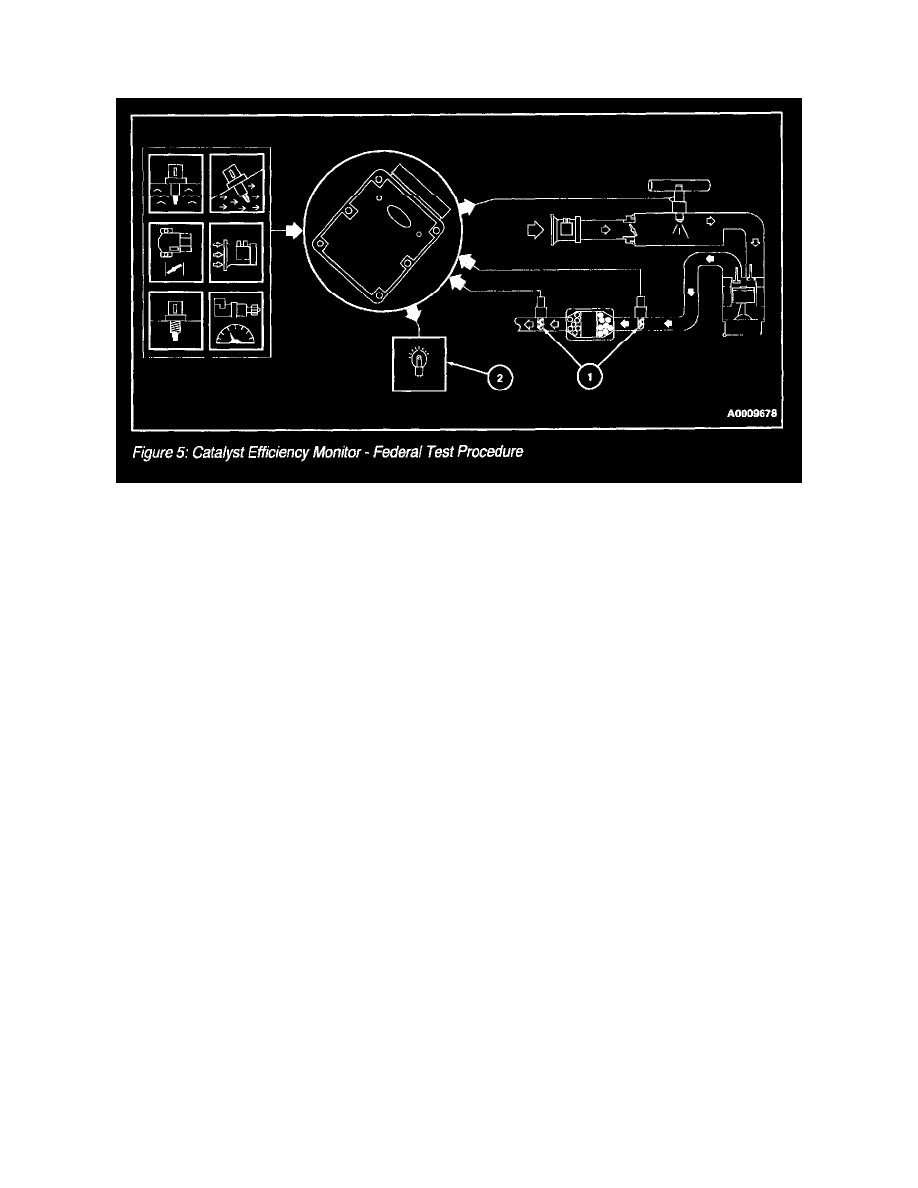Ranger 2WD V6-3.0L VIN V Flex Fuel (2001)

Catalytic Converter: Description and Operation
Catalyst Efficiency Monitor - Federal Test Procedure
Catalyst Efficiency Monitor - Federal Test Procedure
The Catalyst Efficiency Monitor uses an oxygen sensor before and after the catalyst to infer the hydrocarbon efficiency based on oxygen storage capacity
of the catalyst. Under normal, close-loop fuel conditions, high efficiency catalysts have significant oxygen storage. This makes the switching frequency
of the rear Heated Oxygen Sensor (HO2S) very slow and reduces the amplitude of those switches as compared to the switching frequency and amplitude
of the front HO2S. As the catalyst efficiency deteriorates, its ability to store oxygen declines. The post-catalyst or downstream HO2S signal begins to
switch more rapidly with increasing amplitude, approaching the switching frequency and amplitude of the pre-catalyst or upstream HO2S.
All applications utilize an FTP-based (Federal Test Procedure) catalyst monitor. This simply means that the catalyst monitor must run during a standard
FTP emission test as opposed to the 20-second steady state catalyst monitor used in 1994 through some 1996 vehicles. Two slightly different versions of
the catalyst monitor are used in the 2001 model year.
Switch Ratio Method (1996 - 2001)
1. In order to assess catalyst oxygen storage, the monitor counts front and rear HO2S switches during part-throttle, close-loop fuel condition after
the engine is warmed-up and inferred catalyst temperature is within limits. Front switches are accumulated in up to nine different air mass
regions or cells although three air mass regions is typical. Rear switches are counted in a single cell for all air mass regions. When the required
number of front switches has accumulated in each cell, the total number of rear switches is divided by the total number of front switches to
compute a switch ratio. A switch ratio near 0.0 indicates high oxygen storage capacity, hence high HC efficiency. A switch ratio near 1.0
indicates low oxygen storage capacity, hence low HC efficiency. If the actual switch ratio exceeds a calibrated threshold switch ratio, the
catalyst is considered failed.
Inputs from Engine Coolant Temperature (ECT) or Cylinder Head Temperature (CHT) (warm engine), IAT (not extreme ambient
temperatures), Mass Air Flow (MAF) (greater than minimum engine load), Vehicle Speed Sensor (VSS) (within vehicle speed widow) and
Throttle Position (TP) (at part-throttle) are required to enable the Catalyst Efficiency Monitor.
2. The DTCs associated with this test are Diagnostic Trouble Code (DTC) P0420 (Bank 1) and P0430 (Bank 2). Because an Exponentially
Weight Moving Average algorithm is use for malfunction determination, up to six driving cycles may be required to illuminate the Malfunction
Indicator Lamp (MIL) during normal customer driving. If Keep Alive Memory (KAM) is reset, a malfunction will illuminate the MIL in 2
drive cycles.
Index Ratio Method (some 2001 and beyond)
1. In order to assess catalyst oxygen storage, the catalyst monitor counts front HO2S switches during part-throttle, closed-loop fuel conditions
after the engine is warmed-up and inferred catalyst temperature is within limits. Front switches are accumulated in up to three different air
mass regions or cells. While catalyst monitoring entry conditions are being met, the front and rear HO2S signal lengths are continually being
calculated. When the required number of front switches has accumulated in each cell, the total signal length of the rear HO2S is divided by the
total signal length of the front HO2S to compute a catalyst index ratio. An index ratio near 0.0 indicates high oxygen storage capacity, hence
high efficiency. A switch ratio near 1.0 indicates low oxygen storage capacity, hence low HC efficiency. If the actual index ratio exceeds the
threshold index ratio, the catalyst is considered failed.
